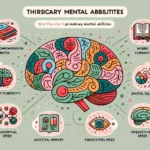Title: Thurstone’s Primary Mental Abilities: Understanding Cognitive Abilities
Description: Learn about Thurstone’s Primary Mental Abilities Test, a cognitive testing tool designed by Louis Thurstone to evaluate seven distinct mental capabilities. Dive into the significance and components of this psychological assessment.
Keywords: Thurstone’s Primary Mental Abilities, cognitive testing, psychological assessment, mental capabilities, intelligence testing, Louis Thurstone.
—
Thurstone’s Primary Mental Abilities (PMA) are a model of cognitive structure that was formulated by psychologist Louis L. Thurstone in the early 20th century. This theory posits that human intelligence is composed of several distinct dimensions, which are independent of one another, unlike the singular IQ measure. These abilities are essential to understanding and assessing individual cognitive functions and are commonly evaluated through the PMA test. Here’s a breakdown of each Primary Mental Ability in detail:
**1. Verbal Comprehension:** The ability to understand verbal and written language. It involves word comprehension, sentence structure, and the ability to grasp the meaning behind phrases and words.
**2. Word Fluency:** This refers to the ease with which a person can produce words. It’s not only about vocabulary size but also about the ability to think of words quickly.
**3. Number Facility:** Number Facility is the capacity to perform simple arithmetic tasks rapidly and accurately. This may include basic calculations and numerical reasoning.
**4. Spatial Visualization:** This ability involves visualizing and mentally manipulating objects. It includes skills like puzzle-solving and understanding geometric relationships.
**5. Associative Memory:** The ability to recall associations between unrelated items. Such memory includes the capacity to remember names, faces, numbers, and places.
**6. Perceptual Speed:** This is about quickly and accurately identifying similarities and differences among various visual stimuli. It includes tasks such as matching figures and proofreading.
**7. Reasoning:** Reasoning is the power to discover rules and apply logical thinking to find solutions to new problems. This ability is fundamental in strategic planning and problem-solving.
The assessment of these primary mental abilities is often used in educational and occupational contexts, providing valuable insight into an individual’s strengths and challenges. Organizations may leverage the PMA’s test in talent acquisition to evaluate job candidates’ cognitive profiles, ensuring they match the requirements of specific roles. Moreover, educators can use this understanding of mental abilities to tailor teaching methods and interventions to enhance student learning outcomes.
In recent years, the study and measurement of Thurstone’s Primary Mental Abilities continue to shape cognitive testing. Modern assessments often build upon or incorporate aspects of the PMA model, reflecting its lasting influence in the field of psychology and intelligence testing methodologies. As an essential tool in cognitive testing, Thurstone’s PMA model offers a multifaceted approach to understanding intelligence, beyond the confines of a single IQ score.

